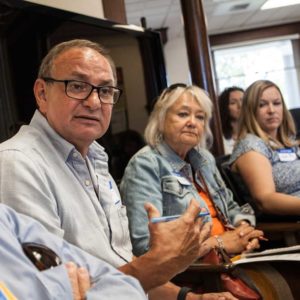Washington’s youth have limitless potential. They’re the future of this state and the heartbeat of our communities. And when they succeed, we all succeed.
Unfortunately, due to circumstances often beyond their control, too many young people have fallen into homelessness or are at risk of becoming homeless. In Washington state alone, 13,000 unaccompanied youth experience homelessness at some point each year. That’s enough to fill 185 school buses.
And these are Washington residents—78 percent of unaccompanied homeless students began 9th grade in the state.
Working together, we can change this
We envision a future where every family and youth has the individualized support they need so that no young person has to spend a single night without a safe and stable home. In an increasingly polarized political climate, people on both sides of the aisle support this mission.
That’s why, last summer and fall, A Way Home Washington co-chair and Washington state First Lady Trudi Inslee and Executive Director of the Office Homeless Youth Kim Justice, toured the state to learn what youth homelessness looks like in Washington state and how service providers are responding. We learned a lot from that listening tour about what is needed to better serve these young people.
We also were blown away by the spirit of community that exists here. Washington state residents are stepping up—as service providers, volunteers, host home families, school employees, counselors, and more—to lend a helping hand to young people in need. People in Washington state feel a sense of responsibility for their community, and especially for the most vulnerable citizens.
Paving the road ahead
In order to prevent and end youth homelessness in Washington state, we need a roadmap that can help get us there. And while a map serves as a great guide to get us to our destination, we’ll need flexibility to navigate the twists and turns along the way.
That’s why the Office of Homeless Youth released their Prevention & Protection Programs 2016 Report – a roadmap to help communities implement solutions that work for them.
The report synthesizes input and expertise from countless individuals and organizations from communities across the state, both public and private. What’s more, a robust and concentrated effort was made to engage young people who are currently experiencing homelessness to provide the perspective and guidance from those who have lived through this unique and life-changing burden.
This month, A Way Home Washington and the Office of Homeless Youth announced a directive from Governor Jay Inslee and proposed specific actions designed to prevent and end youth homelessness in communities throughout Washington state.
This report lays out the key points and programs that can help us turn the tide on youth homelessness. That includes proposals like elevating the voices of those who have experienced homelessness, to specific policy proposals that can shed more light on the problem—such as a homeless youth liaison for every school.
Together, we can
A Way Home Washington is committed to doing our part as well. We will provide state and local leadership, support and technical assistance to build a coordinated, youth-informed system that values family preservation, emergency response, long-term housing, and support services. We will build a movement to expand a sustainable base of support to ensure all youth are safely housed.
To meet our goal of preventing and ending youth homelessness in our state, we need to work with communities across the state to implement the community-based, local solutions that will meet young people where they are and the circumstances they are in.
We encourage you to read through the report and share with your partners, stakeholders, and friends. Together, we can prevent and end youth homelessness in Washington state.

 the expanding crisis of youth and young adult homelessness. Our task now is to ensure every community has the awareness, information and support needed to take action.”
the expanding crisis of youth and young adult homelessness. Our task now is to ensure every community has the awareness, information and support needed to take action.”